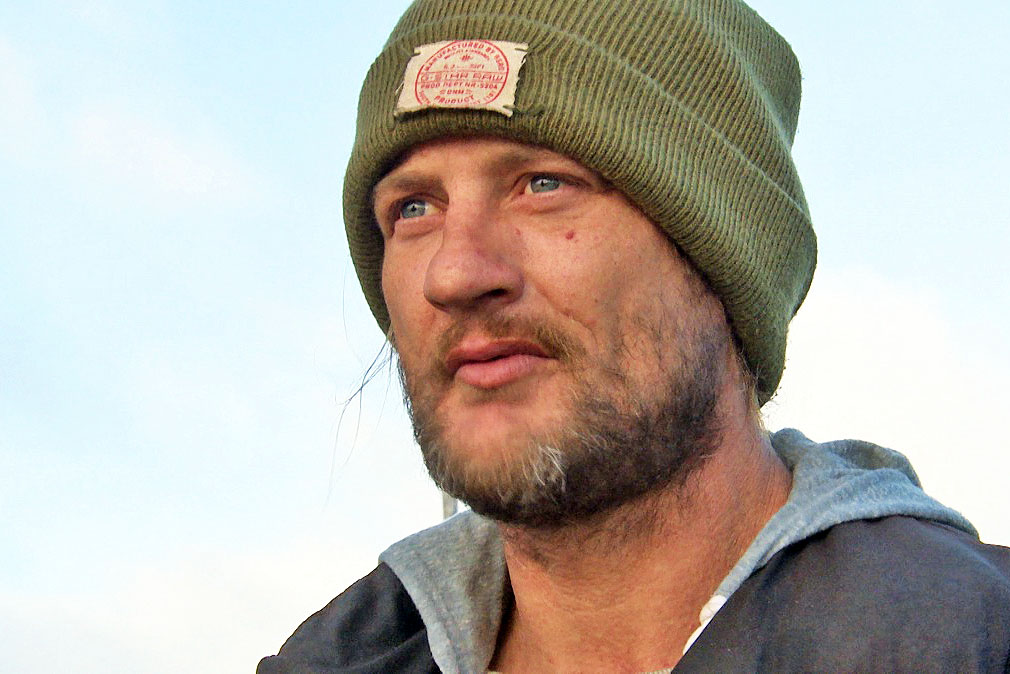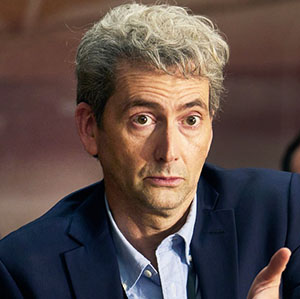Michael, aged forty-four, lives alone in a public housing unit in the Melbourne suburb of Seddon. The place is a tip. “Yeah, I know,” he says in response to the stern gaze of his dog Kaiser. “I got to clean up.” But not today. Today Michael has something else to do. “Gotta bury Mum.” It’s going to be a humiliating experience, because he doesn’t have any shoes and will have to get there by bus, without knowing the route. Later, we watch him as he waits in mounting frustration at the bus stop. He smokes a cigarette. Drinks a bottle of beer. Two bottles. Then suddenly breaks down into a hopeless fit of sobbing.
Why do we watch this? Why is there a whole television crew standing there with him, doing absolutely nothing to help? This question was surging in the twittersphere as the opening episode of Struggle Street 2 went to air. Couldn’t they have given him a lift at least, or bought him a pair of shoes? One of the conventions of documentary journalism is that you don’t interfere. The task is to bear witness, so that audiences can learn about the realities of a situation that is outside their own sphere of experience.
There are, of course, many cases in which, off camera, journalists have helped those they have filmed in situations of conflict and disaster. But the principle is that when reality gets ugly, viewers should see it how it is, and not be shielded by some isolated rescue effort on the part of a camera crew who have teleported into the situation. Michael’s story is documented to illustrate the kind of thing that is happening in thousands of lives in disadvantaged areas around Australia, and the aim, presumably, is to raise public consciousness in ways that may lead to effective social change.
Presumably. Struggle Street 2 belongs to a genre that is somewhere between documentary and reality TV. The aims of documentary are to provide insight and information about a matter of public concern. Reality TV seeks to tap into our curiosity about the private lives and personal behaviour of others as they make their way through some kind of obstacle course. Combining the two approaches results in a strangely uncertain balance between sociology and soap opera, and aims become confused.
Sylvania Waters, aired on the ABC in 1992, was the first Australian series in the hybrid genre. It was controversial in its exposure of the pretensions of residents in a new bourgeois suburb, and in doing so it appealed to some snobbish forms of censoriousness in the viewing audience. Noeline Donaher, the matriarch in the family at the centre of the narrative, complained that she and her family were victims of “cruel and vicious” editing designed to portray them as vulgar materialists with crude racist attitudes. The effects on their lives, she claimed, were profoundly damaging.
The trend for reality series focusing on impoverished neighbourhoods took hold in Britain with The Scheme, shown on BBC Scotland in 2010–11, which won a BAFTA for its unflinching portrayal of the crises faced by families living in housing estates in Kilmarnock, but was also widely condemned as “poverty porn.” That label has subsequently been applied to Skint (2013) and Benefits Street (2014), both made for Channel 4, and the first series of Struggle Street, broadcast on SBS in May 2015.
There are recurring patterns in these series. People trapped in long-term unemployment are prone to drug and alcohol dependency, which may also be associated with mental health conditions. The stress factors mount: fear of eviction and homelessness, debt, legal threats from financial organisations, family conflict, violent behaviour triggered by addiction. Those caught in the cycle of rolling crises have better and worse days, alternating between stoic determination and utter misery. It all makes for strong storylines, tense with the prospect of imminent catastrophe. “It’s a big reality,” says one participant, staring into the camera.
In this latest series of Struggle Street, we watch Jess, a young woman with a degenerative condition that afflicts her with chronic pain, trying to negotiate the acquisition of a wheelchair. It costs $3000, of which the government contribution is just $1000. “You’re doing well, though,” says the disability services officer who has brought the chair round to show her. “One day at a time.” Jess is not doing well. Jess is at breaking point, and so is her mother, who has given up work to be a full-time carer.
Poverty, as the saying goes, is a trap, and watching someone struggle in it from the relative comfort of your living room is a strange form of voyeurism. These programs may induce strong feelings of sympathy or anger, but to what effect? A temporary surge in donations to relevant charities and a brief flurry of complaints to councils and parliamentarians just become part of the spectator sport, with little long-term impact.
And it would be ingenuous to believe that such responses are the goal of the program-makers. Their eyes are firmly on the ratings, where the scores are exactly what they want to see. Series one of Skint drew an audience of over four million; Benefits Street peaked at over five million. The first series of Struggle Street, with 1.3 million viewers, was the highest-rating documentary ever shown on SBS.
What is especially troubling is how the level of public interest spikes in response to media controversies surrounding the programs. Struggle Street 1 hit the headlines immediately after its premiere, as residents in Mount Druitt protested at the stereotyping of their neighbourhood. A convoy of ten garbage trucks drew up outside the SBS studios, and Blacktown mayor Stephen Bali spoke in support of the demonstration, saying that the series should be re-edited into proper documentary rather than reality TV. The trucks were a form of community statement: “It’s garbage.”
Of all the series so far, Benefits Street has been the most bitterly controversial, generating a spate of television debates in which speakers aired hostile views about welfare and bludging. Some of those featured in the programs complained that, having been persuaded to appear in a documentary “about community spirit,” they found themselves featured in a stereotyping exercise that made them into targets of public hostility. The series title — not chosen until two weeks before the first episode went to air — and the narrative shaping done in the editing room combined to skew the perspective towards the issue of welfare dependency rather than the challenges of trying to survive when the odds are overwhelmingly stacked against you.
The title of Struggle Street signals a pointed reversal of emphasis, and there is a persistent focus on the ways in which people help others who are in desperate straits. In the suburb of Inala near Brisbane, where unemployment is 20 per cent, the Koha shed provides emergency accommodation and meals to people who would otherwise be destitute. The shed was set up by two New Zealanders in 2015, initially to help fellow Kiwis who aren’t eligible for benefits, but now they will help anyone they can. Ice addiction is a serious problem in the area, and we hear from recovering addicts who say the Koha helped turn their lives around.
Sometimes, though, those who hold out a helping hand get pulled into the quicksand. Norma, an Aboriginal woman with a large family, who provides an open house to whoever needs a bed, is facing eviction from her housing commission home. Technically, it’s because her daughter smoked marijuana on the premises, but evidently there have been neighbourhood concerns about all the people coming and going. On the day of her eviction, some thirty police officers arrive at her front door, jostling her as she carries one of the younger children out.
Norma made a guest appearance in a discussion broadcast on NITV after the second episode went to air. Asked how she felt about the scene in retrospect, she said, “It’s a nightmare just to watch it.” So why allow the cameras in? She was tired of not being heard, she said. “I want people to know what’s going on.” There’s no limit to what’s going on in our apparently prosperous country. This second series of Struggle Street runs to six episodes, each of them an unrelenting saga of human misery and desperation.
In one of the later episodes, Michael visits his doctor and asks for a diazepam prescription, because he can feel himself sinking into alcoholism. He’s running on empty, he says. The doctor, speaking to camera, offers a comment. “It might just be that our society has become more difficult to live in. There’s less support, less cohesion, so people like Michael often feel that no one cares.” Surely in today’s circumstances a man in Michael’s predicament would find a neighbour to lend him shoes for his mother’s funeral, and someone to accompany him as he made the journey.
“We all come together as one,” says a youth from the Cook Islander community at the start of the first episode. “We’re all family here.” But evidently that is not always the case. Disability, mental illness, addiction and perpetual unemployment strain families and communities to breaking point. This is where the wider social network must be called upon, with all its resources.
What we are really witnessing in these programs is something much deeper than poverty. It’s the human disintegration that occurs in a dispossessed society. In Margaret Thatcher’s famous dictum, there is no such thing as society. The policies she championed, still being implemented by governments committed to the neoliberal ideology she espoused, have worn away the social fabric until it is threadbare.
A documentary concerned with why and how this happens, and what might be done to reverse it, would be a valuable enterprise. For program-makers in the television industry to observe its worst consequences so that we can watch them too, and do nothing, is only a symptom of the pathology. ⦁




